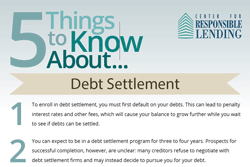Debt settlement companies offer the promise of settling a consumer's debt for a fraction of what they owe. The idea is simple: debt settlement companies offer to negotiate down the outstanding debt (usually from credit cards) owed to a more manageable amount so that a consumer can become debt free. Unfortunately debt settlement carries significant risks that may result in consumers becoming even worse off.
Debt settlement is inherently a risky venture: in order to enroll into debt settlement programs, consumers are required to default on their debt which often results in fees, increased interest rates, and sometimes even lawsuits from creditors. Even after assuming all this risk, consumers are offered no guarantees; in fact, some creditors refuse to negotiate with debt settlement companies at all. Even if a settlement is reached, a consumer unable to keep up with the new settlement arrangement risks falling back into default – and now without the fees paid to the debt settlement company for negotiating the agreement. CRL finds that consumers must settle at least two-thirds of the debt they enroll in a debt settlement program to benefit, a result that many will not achieve.
This chapter examines the debt settlement industry, the risks to consumers, and recommends actions at both the federal and state levels to reduce the potential harm to consumers.
The chapter finds:
- Debt settlement is a risky strategy for debt reduction – and often leaves consumers more financially vulnerable.
- Consumers must settle two-thirds of their debt to be better off than they were before – and many consumers are unlikely to reach that level of success.
- Strong state and federal laws could curb risks associated with debt settlement.
5 Things You Need to Know About Debt Settlement [PDF]
Debt settlement promises relief, but often it deliver deeper debt. Learn the 5 things you need to know about debt settlement and understand why it's a risky prospect for many consumers.
